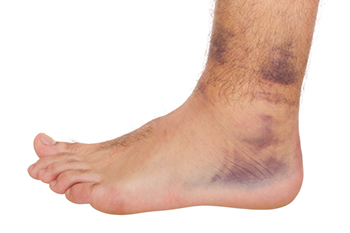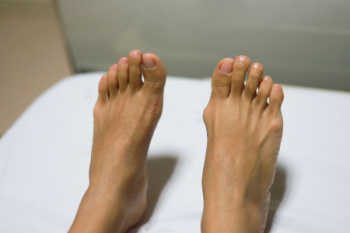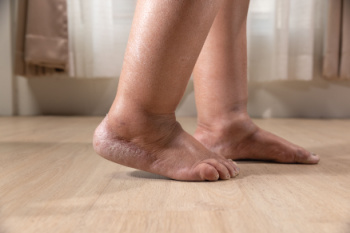Items filtered by date: June 2024
Three Types of Ankle Sprains

Ankle sprains are common injuries classified into three types based on their degree and severity. A first-degree sprain is the mildest form, involving slight stretching or microscopic tearing of the ligament fibers. Symptoms include mild pain, swelling, and stiffness, with little to no instability in the ankle joint. A second-degree sprain is more severe, characterized by partial tearing of the ligament. This type results in moderate pain, swelling, and bruising, with some difficulty bearing weight and noticeable instability in the ankle. The most severe is a third-degree sprain, where the ligament is completely torn. This causes significant pain, swelling, and bruising, in addition to a substantial loss of function and stability in the ankle. Recovery times vary depending on the severity, with mild sprains healing within a few weeks and severe sprains potentially taking several months. If you have suffered a sprained ankle, it is suggested that you consult a podiatrist who can determine what type of sprain you have endured, and offer correct treatment for it.
Although ankle sprains are common, they aren’t always minor injuries. If you need your ankle injury looked at, contact Cecilia Capuano-King, DPM from New York. Our doctor can provide the care you need to keep you pain-free and on your feet.
How Does an Ankle Sprain Occur?
Ankle sprains are the result of a tear in the ligaments within the ankle. These injuries may happen when you make a rapid shifting movement while your foot is planted. A less common way to sprain your ankle is when your ankle rolls inward while your foot turns outward.
What Are the Symptoms?
- Pain at the sight of the tear
- Bruising/Swelling
- Ankle area is tender to touch
- In severe cases, may hear/feel something tear
- Skin discoloration
Preventing a Sprain
- Wearing appropriate shoes for the occasion
- Stretching before exercises and sports
- Knowing your limits
Treatment of a Sprain
In many cases, the RICE method (Rest, Ice, Compression, and Elevate) is used to treat ankle sprains. However, you should see a podiatrist to see which treatment option would work best with your injury. In severe cases, surgery may be required.
It is important to ask your doctor about rehab options after you receive treatment for your injury. Stretching, strength training, and balance exercises may help the ankle heal while also preventing further injury.
If you have any questions, please feel free to contact our office located in Smithtown, NY . We offer the newest diagnostic and treatment technologies for all your foot care needs.
Stop Your Toenail Fungus
Tending to Bunions
 Bunions are bony bumps that form on the joint at the base of the big toe, causing the toe to deviate towards the other toes. They appear as swollen, protruding lumps on the side of the foot and can be red and tender. The condition can cause significant discomfort, including pain, swelling, and restricted movement of the big toe. Bunions often develop due to inherited foot structure, wearing tight or ill-fitting shoes, arthritis, or excessive stress on the feet. High heels and pointed shoes are common culprits in exacerbating bunions. Symptoms typically include pain, especially while walking, and inflammation surrounding the affected joint. Treatment for bunions ranges from conservative measures to surgery. Wearing wider shoes, using bunion pads, and taking anti-inflammatory medications can help to alleviate symptoms. Orthotic devices may help correct foot alignment. In severe cases, surgical intervention may be necessary to realign the bone and relieve pain. Untreated bunions can lead to complications such as bursitis or hammertoes. If you have a bunion that is causing you discomfort, it is suggested that you schedule an appointment with a podiatrist for treatment.
Bunions are bony bumps that form on the joint at the base of the big toe, causing the toe to deviate towards the other toes. They appear as swollen, protruding lumps on the side of the foot and can be red and tender. The condition can cause significant discomfort, including pain, swelling, and restricted movement of the big toe. Bunions often develop due to inherited foot structure, wearing tight or ill-fitting shoes, arthritis, or excessive stress on the feet. High heels and pointed shoes are common culprits in exacerbating bunions. Symptoms typically include pain, especially while walking, and inflammation surrounding the affected joint. Treatment for bunions ranges from conservative measures to surgery. Wearing wider shoes, using bunion pads, and taking anti-inflammatory medications can help to alleviate symptoms. Orthotic devices may help correct foot alignment. In severe cases, surgical intervention may be necessary to realign the bone and relieve pain. Untreated bunions can lead to complications such as bursitis or hammertoes. If you have a bunion that is causing you discomfort, it is suggested that you schedule an appointment with a podiatrist for treatment.
If you are suffering from bunions, contact Cecilia Capuano-King, DPM of New York. Our doctor can provide the care you need to keep you pain-free and on your feet.
What Is a Bunion?
A bunion is formed of swollen tissue or an enlargement of boney growth, usually located at the base joint of the toe that connects to the foot. The swelling occurs due to the bones in the big toe shifting inward, which impacts the other toes of the foot. This causes the area around the base of the big toe to become inflamed and painful.
Why Do Bunions Form?
Genetics – Susceptibility to bunions are often hereditary
Stress on the feet – Poorly fitted and uncomfortable footwear that places stress on feet, such as heels, can worsen existing bunions
How Are Bunions Diagnosed?
Doctors often perform two tests – blood tests and x-rays – when trying to diagnose bunions, especially in the early stages of development. Blood tests help determine if the foot pain is being caused by something else, such as arthritis, while x-rays provide a clear picture of your bone structure to your doctor.
How Are Bunions Treated?
- Refrain from wearing heels or similar shoes that cause discomfort
- Select wider shoes that can provide more comfort and reduce pain
- Anti-inflammatory and pain management drugs
- Orthotics or foot inserts
- Surgery
If you have any questions, please feel free to contact our office located in Smithtown, NY . We offer the newest diagnostic and treatment technologies for all your foot care needs.
Why Ankles Can Hurt from Running

Running is an excellent way to stay fit, but it can sometimes lead to ankle pain. This discomfort often arises from overuse, improper footwear, or running on uneven surfaces. When you run, your ankles absorb significant impact with each step, which can strain the ligaments, tendons, and muscles around the joint. Overuse injuries occur when the ankle is repeatedly stressed without sufficient rest, leading to inflammation and pain. Wearing shoes that do not provide adequate support or cushioning can worsen this issue, as can running on surfaces that are too hard or uneven, increasing the risk of spraining the ankle. Additionally, biomechanical issues, such as improper running form or flat feet, can contribute to ankle pain by placing extra strain on the joint. To prevent ankle pain, it is important to wear proper running shoes and run on suitable surfaces. If you have developed ankle pain from running, it is suggested that you contact a podiatrist who can guide you toward relief and injury prevention tips.
Sports related foot and ankle injuries require proper treatment before players can go back to their regular routines. For more information, contact Cecilia Capuano-King, DPM of New York. Our doctor can provide the care you need to keep you pain-free and on your feet.
Sports Related Foot and Ankle Injuries
Foot and ankle injuries are a common occurrence when it comes to athletes of any sport. While many athletes dismiss the initial aches and pains, the truth is that ignoring potential foot and ankle injuries can lead to serious problems. As athletes continue to place pressure and strain the area further, a mild injury can turn into something as serious as a rupture and may lead to a permanent disability. There are many factors that contribute to sports related foot and ankle injuries, which include failure to warm up properly, not providing support or wearing bad footwear. Common injuries and conditions athletes face, including:
- Plantar Fasciitis
- Plantar Fasciosis
- Achilles Tendinitis
- Achilles Tendon Rupture
- Ankle Sprains
Sports related injuries are commonly treated using the RICE method. This includes rest, applying ice to the injured area, compression and elevating the ankle. More serious sprains and injuries may require surgery, which could include arthroscopic and reconstructive surgery. Rehabilitation and therapy may also be required in order to get any recovering athlete to become fully functional again. Any unusual aches and pains an athlete sustains must be evaluated by a licensed, reputable medical professional.
If you have any questions please feel free to contact our office located in Smithtown, NY . We offer the newest diagnostic and treatment technologies for all your foot and ankle needs.
Causes of Swelling in the Legs and Feet
 Edema in the legs and feet is a common condition characterized by swelling. The swelling is caused by excess fluid trapped in bodily tissues. Many factors can contribute to such swelling, like standing or sitting for long periods, which hinders proper blood flow. It also may stem from serious underlying health issues, including heart disease, kidney problems, or liver disease. Other contributing factors to edema include pregnancy, obesity, and certain medications that may cause fluid retention. Symptoms of edema include swollen, puffy skin that may feel tight. When the skin is pressed, it may also produce a dimple. There are many treatment options for edema, and a podiatrist, or foot doctor, is a specialist that can provide a personalized treatment plan. If you are affected by swollen feet and legs, it is suggested that you make an appointment with a podiatrist today for proper care.
Edema in the legs and feet is a common condition characterized by swelling. The swelling is caused by excess fluid trapped in bodily tissues. Many factors can contribute to such swelling, like standing or sitting for long periods, which hinders proper blood flow. It also may stem from serious underlying health issues, including heart disease, kidney problems, or liver disease. Other contributing factors to edema include pregnancy, obesity, and certain medications that may cause fluid retention. Symptoms of edema include swollen, puffy skin that may feel tight. When the skin is pressed, it may also produce a dimple. There are many treatment options for edema, and a podiatrist, or foot doctor, is a specialist that can provide a personalized treatment plan. If you are affected by swollen feet and legs, it is suggested that you make an appointment with a podiatrist today for proper care.
Swollen feet can be a sign of an underlying condition. If you have any concerns, contact Cecilia Capuano-King, DPM of New York. Our doctor can provide the care you need to keep you pain-free and on your feet.
Swollen feet are a common ailment among pregnant women and people who stand or sit for extended periods. Aging may increase the possibility of swollen feet and patients who are obese often notice when their feet are swelling too. There may be medical reasons why swollen feet occur:
- Phlebitis - A condition that causes the veins to become inflamed and can also cause leg pain.
- Liver disease - This may lead to low blood levels of albumin which is a protein. This can cause fluid in the blood to pass into the tissues and several areas of the body can become swollen.
- Heart failure - When the heart doesn’t pump properly the blood that is normally pumped back to the heart can pool in the veins of the legs causing swollen feet.
- Kidney disease - One of the main functions of the kidneys is releasing excess fluid in the body. This type of condition can make it difficult for the kidneys to function properly, and as a result the feet may become swollen.
- Deep-vein thrombosis (DVT)- This is a serious condition where blood clots form in the veins of the legs. They can block the return of blood from the legs to the heart which may cause the feet to swell. It is important to be treated by a podiatrist if this condition is present.
Swollen feet can also be caused by bone and tendon conditions, including fractures, arthritis, and tendinitis. Additionally, there may be skin and toenail conditions and an infection may cause the feet to swell. Patients who take medicine to treat high blood pressure may be prone to getting swollen feet.
Many patients elevate their feet to help relieve the swelling and this is generally a temporary remedy. When a podiatrist is consulted the reason behind the swelling can be uncovered and subsequently treated.
If you have any questions please feel free to contact our office located in Smithtown, NY . We offer the newest diagnostic tools and technology to treat your foot and ankle needs.

